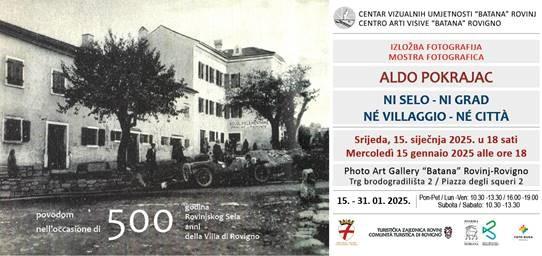Photo exhibition
500 years of Rovinjsko Selo through the prism of the exhibition "Neither a village nor a city" by Aldo Pokrajc
On Wednesday, January 15, 2025 at 6:00 PM, in the Batana Gallery, Trg brodogradilišta 2, we are opening a photography exhibition: Aldo Pokrajac, Neither Village - Nor City on the occasion of 500 years of Rovinjsko Selo. By comparing old and new photographs from the same place and various events recorded, as well as comparative historical maps, the author presents an account of the origin and development of Rovinjsko Selo. Several articles by Aldo Pokrajac previously published in Glas Istre are on display, in which the author writes about significant and deserving residents of Rovinjsko Selo, throughout history to the present day.
For many people from Rovinjsko Selo, especially those who reflect on their past, 2025 is an emblematic year. Namely, around 500 years ago, a large group of immigrants from the hinterland of Zadar appeared before the walls of Rovinj, where the border of the Venetian Republic and the Ottoman Empire was. Pursued by the constant incursions of the Turks into their villages, they set off with their herds towards the northwest and arrived in front of Rovinj, which had no settlement in its vicinity from the direction of Kanfanar. Following this path, Aldo Pokrajac published a feuilleton in Glas Istre in January 2024, before Antonja, the feast of St. Anthony, the patron saint of Rovinjsko Selo, about the past and present of the settlement, which with 1,500 inhabitants is larger than many Istrian municipalities. He investigated how each place is made up of people and which of them are famous in Istria, Croatia and the world. Rovinjsko Selo is fortunate that Vjekoslav Bratulić, a historian at the Adriatic Institute of the Yugoslav Academy of Sciences and Arts, has long studied its past. Based on his research, the JAZU Publishing House published the book "Rovinjsko Selo, monograph of an istrian village" in Zagreb in 1959. In addition to a detailed account of the history of the settlement from published archival sources, including the stratification of the village after World War II, the book also includes photographs by Vjekoslav Bratulić published on fine paper, from which one can discern the architectural changes that Rovinjsko Selo has undergone. On this trail, Aldo Pokrajac set out to find other photographs from the history of Rovinjsko Selo, of which, since it is a rural area, there are not many. The oldest is probably the only postcard of the settlement from 1922, published in the monograph by Marin Budicin and Danijel Načinović "Rovinj on Old Postcards". Significant photographs of Rovinjsko Selo are kept in the Historical and Maritime Museum in Pula, especially the one from 1946, which shows how the Allied commission for visiting Istrian settlements was welcomed. Then there are photographs by F. Neves from 1954, limited to three locations in Rovinjsko Selo. Vjekoslav Bratulić, however, used his photographs to show the remains of prehistoric and ancient sites, ethnographic elements, and then insignificant buildings and veduta. Thanks to Desiderio Dazzara, a photo chronicler of Rovinj and its surroundings, whose contribution to documenting Rovinj has not been sufficiently valorized, the events of 1967 were recorded when the first road bypass of Rovinjsko Selo was opened and a monument to the victims of fascism was unveiled at the execution site, the Velika krasa clearing. Dazzara also photographically documented the opening of a sports center on the site of the buried Lakuverča pond in 1977, which was the source of life around which Rovinjsko Selo was formed. Following the trail of these images, Aldo Pokrajac visited all the locations and photographed how they look today from the same perspective. Unfortunately, new owners who preserved precious architectural elements, primarily baladuras and vaulted spaces that served economic purposes, are rare. In the immediate vicinity of Rovinj, which was too expensive to build, Rovinjsko Selo expanded rapidly, often uncontrollably. This is clearly demonstrated by the Vičani area, directly behind the only traffic light in the area of the City of Rovinj, where houses have been piled on top of houses, resulting in a newly composed one with a flat roof that can hardly fit into traditional construction. The urban plan adopted in 2007 could not correct numerous errors, especially the narrow roads, which were in the nature of former cart roads. Only recently have conservators been trying to preserve, at least along the central Stjepana Žiže Street, the facades that were given decorative elements in the period between the two world wars. The author of the exhibition also photographed buildings that stand out from typical rural houses with their monumentality and architectural solutions. First of all, there is Brdo, whose row of two-story buildings is similar to city construction. Then there is the Plovanija building, which was the center of the administrative authority of the settlement with a carabinieri station and a prison. The elementary school building built between the two world wars also stands out in terms of architectural skill. Based on the research of Dr. sc. Aldo Sošić, a tireless promoter of the history of geodesy, the exhibition also presents the first maps on which Rovinjsko Selo is depicted. On the first one from 1620, Giovani Antonio Magini uses the name Villa nuova. Giovanni Valle drew the name Villa di Rovigno on his map from 1780, and Franjo Vjekoslav Kružić used the name Rovinjsko Selo in 1871. The real changes that Rovinjsko Selo has undergone can be seen on the maps of the State Geodetic Administration, especially when comparing

